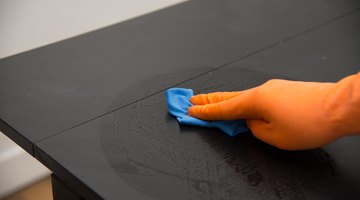How to Remove Cigarette Smell From Wood Furniture
Cigarette smoke isn't just a temporary annoyance -- when it settles on wood furniture, the odor can persist for years. The smoke contains nicotine and tar, which leaves behind a brownish-yellow film that mars furniture's beauty.

Cigarette odor is one of the most stubborn smells to remove, and many standard cleaners aren't tough enough for the job. Smoke-stained furniture isn't destined for the landfill, though. Ammonia and vinegar break down cigarette residue and make wood smell fresh again.
Things You Will Need
- Fan
- Rubber gloves
- Plastic eye goggles
- Lint-free cloths
- Household ammonia or white vinegar
- Buckets
Tip
If the smoke odor remains after cleaning, ask a professional furniture restorer about refinishing the piece. An air purifier may remove some of the smoke smell. Cover the furniture with a large sheet or other cloth to make a tent. Run the air purifier under the tent for several hours. If your furniture has upholstered cushions, you'll need to clean them separately to remove smoke odor. Remove the cushions and take off the slipcovers or upholstery fabric, if possible. Wipe the fabric and padding with a mild fabric cleaner. Use a spray upholstery cleaner if you cannot remove the cushion. Take care not to spray the cleaner on the surrounding wood. After cleaning your furniture, you can protect it from further damage with wax or polish. Use linseed oil for oil finishes. For high-gloss and antique finishes, use paste wax or liquid polish. For a low-gloss finish, use liquid polish made for low-luster wood. Treat satin-gloss finishes with silicone-free cream wax. Apply a small amount of wax or oil to a clean cloth. Rub an even layer of the wax or oil into the wood, working parallel to the grain. Buff the wood with a dry cloth until glossy. You can buy prepared linseed oil at paint stores.
Warning
Never let water or any cleaning solution stand on wood furniture for longer than necessary. Standing liquid can damage wood surfaces.
Ammonia cleaning solutions may discolor or cloud certain wood finishes. Test the solution on a small, hidden part of furniture before applying to the entire piece. If ammonia discolors the finish, use vinegar instead.
-
Place the wood furniture in a well-ventilated room. Open a window, if possible, or run a fan next to the furniture.
-
Put on rubber gloves. Wear plastic eye goggles when cleaning an item over your head, such as a high shelf or cabinet. Goggles prevent cleaning solution from getting in your eyes.
-
Dampen a soft, lint-free cloth with warm water. Wring the cloth to remove as much excess water as possible.
-
Wipe the furniture with the damp cloth to remove dust and debris. Work with one small section at a time. Wipe the wood dry with a clean cloth before moving on to another section.
-
Make a solution of 80 percent warm water and 20 percent household ammonia, or for very strong cigarette odors, use equal parts ammonia and warm water. Alternatively, use white vinegar instead of ammonia. Pour the solution into a bucket and put it near your work area. Fill another bucket with warm water and put it next to the cleaning solution.
-
Set a large stack of cloths next to your work area. Cloths will get very dirty during the cleaning process, so you'll need to change them frequently.
-
Moisten a cloth with the ammonia or vinegar solution, then squeeze out excess liquid. Working parallel to the grain, wipe a small area of the wood with the solution. Avoid wiping glued seams or joints, as this solution can cause separation, swelling or warping. Rough, unfinished wood can snag the cloth, so work carefully around it. As you clean, you'll see the cloth turn yellow or brown due to nicotine and tar breakdown. Swap the cloth for a clean one when it gets too dirty. Moisten each new cloth with ammonia or vinegar solution.
-
Dampen another cloth with clean water, then wipe the area you just cleaned to rinse. Wipe the wood immediately with a dry cloth.
-
Repeat this process until you've wiped the entire piece of furniture with the cleaning solution. To get rid of the smoke odor, you need to thoroughly clean all surfaces, such as legs, underside of the frame, both sides of shelves and insides of drawers.









The Drip Cap
- Cigarette smoke isn't just a temporary annoyance -- when it settles on wood furniture, the odor can persist for years.
- Ammonia and vinegar break down cigarette residue and make wood smell fresh again.
- Dampen a soft, lint-free cloth with warm water.
- Pour the solution into a bucket and put it near your work area.
- Cloths will get very dirty during the cleaning process, so you'll need to change them frequently.
- Moisten a cloth with the ammonia or vinegar solution, then squeeze out excess liquid.
- Swap the cloth for a clean one when it gets too dirty.
References
- Chicago Tribune: Ridding Stale Odors From Wood Furniture
- Utah State University Cooperative Extension: Cleaning, Repairing and Reconditioning Wood Furniture
- RJ Fine Woodworking: Custom Wood Furniture Care and Cleaning Tips
- The Christian Science Monitor: Proper Care of Wood Finishes Pays Dividends in Beauty and Shine
Writer Bio
Melissa King began writing in 2001. She spent three years writing for her local newspaper, "The Colt," writing editorials, news stories, product reviews and entertainment pieces. She is also the owner and operator of Howbert Freelance Writing. King holds an Associate of Arts in communications from Tarrant County College.
Photo Credits
- Artem Kononenko/Demand Media
- Artem Kononenko/Demand Media
- Artem Kononenko/Demand Media
- Artem Kononenko/Demand Media
- Artem Kononenko/Demand Media
- Artem Kononenko/Demand Media
- Artem Kononenko/Demand Media
- Artem Kononenko/Demand Media
- Artem Kononenko/Demand Media
- Artem Kononenko/Demand Media
- Artem Kononenko/Demand Media
More Articles



